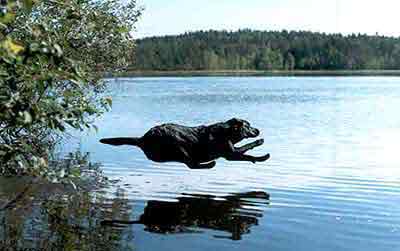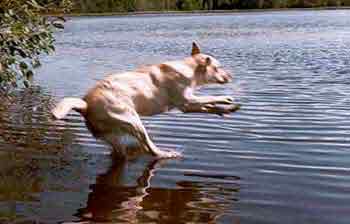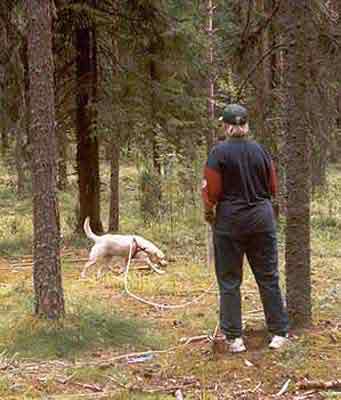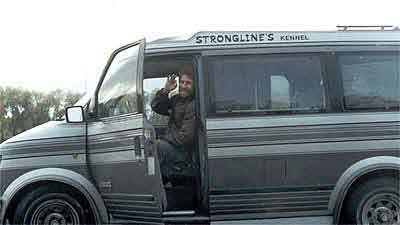
|
|
Before my story about retriever's testing in Finland, I would like to note that it is not a guide to action in our country. These are not ever rules which are used in retrievers' testing in Finland. The writer of this article is a repeated participant of such tests in this country. I think my narration will be interesting for everyone who is interested in working qualities of their retrievers. Moreover it is not a s��ret that this group of dogs was raised as a working group.

First of all I'd like to say a few words about field test. In the US, in England or in Finland and other countries it is not based on the living objects of hunting. They use only shooting birds and animals. Is a test is complicated, living objects of hunting can be used as minor elements to estimate the powers of retrievers.
 I
know three stages of retrievers testing in Finland. The first stage is called
Field Test, is a retriever passes this field test, he or she will be given an
international working certificate. Obviously, it means that you can hunt with
this dog. This test includes control of bringing birds and animals from the
water and dry-land, the dog's reaction to shoot, obedience, communication with
handler, the dog's activity when it is looking for hunting objects, width of
search etc. As far as I know the Finns don't give points to a dog when it is
passing the test . They simply estimate its work. They conclude: "The work is
done by the dog" or "The work is not done by the dog". It is a referee who
estimates the work, the activity of the retriever considering each item of the
test. A group of assistants is fixed to help a referee prepare everything for
the test. I know that a referee ignores the assistants' opinion concerning
retrievers' work.
I
know three stages of retrievers testing in Finland. The first stage is called
Field Test, is a retriever passes this field test, he or she will be given an
international working certificate. Obviously, it means that you can hunt with
this dog. This test includes control of bringing birds and animals from the
water and dry-land, the dog's reaction to shoot, obedience, communication with
handler, the dog's activity when it is looking for hunting objects, width of
search etc. As far as I know the Finns don't give points to a dog when it is
passing the test . They simply estimate its work. They conclude: "The work is
done by the dog" or "The work is not done by the dog". It is a referee who
estimates the work, the activity of the retriever considering each item of the
test. A group of assistants is fixed to help a referee prepare everything for
the test. I know that a referee ignores the assistants' opinion concerning
retrievers' work.
Now, we will move on to the test properly. My
dog three times. Only fourteen dogs are always put to the test because it is
physically impossible to test a lot of dogs. You can find only referee, a one or
two assistants, dogs with handlers, spectators without dogs in the area of
testing. The number of spectators is unlimited. The distance between the
spectators and the start line is 10 meters. The spectators can be a real
obstacle because they are allowed to laugh, speak, scream, walk, run, smoke, eat
strong fragrant food and so on. But they are not allowed to draw away the dog's
attention by whistling or calling up a dog.
Now the test is carried out: From the very beginning a handler with a dog is in the settling area. Then an assistant invites them to the area of testing. He cries out "Seura Va-a-a-a". It means "the next".
The dog must move steadily near the handler's leg without jerks or speeding on. First of all they move to water. Here the dog is seated. The distance between the dog and the water is about 2-5 meters. The dog is held across the neck by a taken off leash.
An assistant (mainly a lady) stands in a shooting position, quack like a duck, shoots into the air (it's a blank shot), throws a huge sea-gull (it weighs 1kg and half ). The assistant tries to throw it as far as she can (the distance between the assistant and sea-gull is about 10 meters).The handler is supposed to draw his dog's attention to the assistant's actions, which I have just described. A referee always speaks Finnish. He gives a command for the dog to start. The dog must immediately jump into the water, bring a sea-gull and put it into the handler's hands. The sea-gull (which is brought by the dog) is given to a boat-man. He sails out 50-70 meters from the shore. The assistant shoots. The boat-man quacks like a duck and throws the sea-gull away as far as he can.
 After
that he stands still. And the referee gives his command and the dog goes into
the water. It swims directly towards the sea-gull, catches it, brings it to the
handler. The dog must put the sea-gull into the handler's hands. The handler
should direct his dog only when it is start. The water test is over. The referee
examines the sea-gull. It mustn't be damaged by the dog's teeth. If the sea-gull
is damaged, the dog may be discharged by the referee.
After
that he stands still. And the referee gives his command and the dog goes into
the water. It swims directly towards the sea-gull, catches it, brings it to the
handler. The dog must put the sea-gull into the handler's hands. The handler
should direct his dog only when it is start. The water test is over. The referee
examines the sea-gull. It mustn't be damaged by the dog's teeth. If the sea-gull
is damaged, the dog may be discharged by the referee.
After the water test, the test on searching and bringing catch on dry land is carried out. The test take place in the forest which is situated nearby. The forest (the area of testing) must be typical for the country. I think it is a national peculiarity which should be taken into consideration. Five birds (they use crows) are placed in the area (70 X 70 meters). During the test this area doesn't change. Each dog work here.
Now, I'd like to pause for a moment. It's obvious that an attentive reader has a question. Will the chances of the first and the last dogs be equal? The area will be trampled down by dogs and assistants. It will be thrown with the objects of hunting. I conclude that the first dog has every prospects of success. Imagine that the first and the next dogs are out of practice. All of them will trample at the start line. If my dog catches the scent of a game-bird, it is able to work. If it goes round fresh dog's traces, it is not able to work. So it is very important to use one and the same area for all the dogs. It reveals its negative and positive qualities when a dog is looking for a game-bird.
The dog with a leash is taken to a start line. It is seated and held by a taken off leash. The referee controls the dog's obedience. He gives his command: "Attention", the assistant shoots, the handler directs his dog. The assistant throws a crow. Then the referee gives his command for the dog to start. The first crow is shot at. The dog can see it. Now this crow is situated not far from the dog. The distance between the dog and the crow is about 20 meters. The handler directs his dog. The dog starts to search for it at once. The referee is near the handler. There is only an assistant in the area of searching. The assistant puts up his (her) hand(or cries if he (she) is out of sight when a game-bird is found. Then the handler can call up his dog to him by whistling. The dog must bring a crow and put it into his hands. The handler must give the crow back to the referee. The referee examines the crow's damages (is it has any). The dog is seated. The referee gives his command for the dog to start. If referee considers it necessary, he can show the searching direction to the handler. The handler can show this direction to the dog (but only once). The dog must start to search at once. It must find and bring six game-birds. But if a referee thinks the dog's work is extremely significant and he has three game-birds on his hands, the dog is considered to have passed this part of the test. Otherwise the dog must continue the searching.
If a dog works more than 15 minutes or can't bring a game-bird for more than 3 times or refuses to search for game-birds for two times, the referee can discharge the dog.
 Those
who are successful in finding and bringing game-birds (5-6 dogs as a rule) can
continue testing and move on to the second stage of field test. It is usually
held in the afternoon (after dinner). It is called field track test. Four years
ago it was called "Blood track". A dog had a twelve meter leash with a
breast-band. A handler couldn't control its dog while it was searching.
Those
who are successful in finding and bringing game-birds (5-6 dogs as a rule) can
continue testing and move on to the second stage of field test. It is usually
held in the afternoon (after dinner). It is called field track test. Four years
ago it was called "Blood track". A dog had a twelve meter leash with a
breast-band. A handler couldn't control its dog while it was searching.
Now a dog performs this task without a leash. It follows in scent tracks (there is no blood tracks) of a gray hare (I don't know why but the Finns call it a rabbit). The dog had to find it in the past. But now the task is more complicated. The dog must find a gray hare, bring it and put it into the hands of handler. The handler must be on the start line.
The track test should be held far from water in a typical part of the forest. An assistant pulls through a have from an improvised bed. The distance between a wild animal's bed and the nearest earth road is about 10 meters. The assistant clears the place (half a meter in diameter) and rubs it with a hare. The traces are pulled through with a shooting animal which is on a cord. It is done for every tested dog in a new place. The trace is about 900 meters long, it has two right angles. It doesn't cross public road. The assistant should near rubber boots. There is only a dog, a handler, a referee and spectators (I have already mentioned about them before) at the start line. Other dogs must be moved off. The distance between the start line and other dogs is about 100 meters.
A referee gives a command for a dog to start. A handler with a dog (which is shown by a referee). A handler shows it to his dog. Then he releases it and gives a searching command. A handler stand still while his dog is searching. A referee is on the road, he doesn't go into the forest.
The dog's searching is observed by a group of assistants. When a dog finds a hare, they inform a referee about it. Then a referee informs a handler. In his turn a handler, calls up his dog by a whistle. A dog bring a hare and puts it into the hands of handler. A hare may weigh 6 or even 7 kg.
A referee usually gives 10 minutes for a dog to complete this part of the test. If a dog doesn't manage in 10 minutes or refuses to search for the second time or damages its catch, this dog is discharged.
 Frankly
speaking it is for a referee to decide. On the one hand it is a matter of
principle, but on the other hand a referee can decide a matter in the dog's
favour (in your favour). He considers the fact a dog may work slowly or on the
contrary it may complete the task with many mistakes. It is important that a
referee always gives a dog some limited time to complete the work carefully and
slowly. Thus a dog always has enough time to finish the task successfully.
Frankly
speaking it is for a referee to decide. On the one hand it is a matter of
principle, but on the other hand a referee can decide a matter in the dog's
favour (in your favour). He considers the fact a dog may work slowly or on the
contrary it may complete the task with many mistakes. It is important that a
referee always gives a dog some limited time to complete the work carefully and
slowly. Thus a dog always has enough time to finish the task successfully.
When a referee estimates the dog's track test, he ignores the fact how a hare was found. It doesn't matter if a dog used an upper an or lower scent, if it cut off angles. Only the result is very significant. If a dog brings a hare, the test will be passed. Now your dog has a chance to become a title-holder of Finland according to the results of the certificate dog show.
I'd like to conclude by saying that it is great if your dog has an international certificate and his (her) Russian Field Test is passed successfully. But if your dog doesn't pass this test in Finland, he (or she) will never become a title-holder (Ch FIN).
Andrei Vinogradov